“-ake on ice.” Where the censors were on that one, I don’t know.
This episode is fascinating, fascinating to me, and here’s why: Ed is clearly better at bounty hunting than anyone else on the BeBop’s crew. Oh, we have seen them capture people before. And technically, she didn’t get the bounty on Domino. But she does bring home the mushrooms. The idea of having enough food has been a constant leitmotif in Cowboy Bebop: Character after character complains about not having food, or fantasizes about the food they’re going to buy once they finally do have money. The whole point of bounty hunting is that if you do it enough, you get to have a banquet. Ed brought home the mushrooms! This is the only episode so far where they do get to have a banquet. Even in the episodes where the crew successfully captures someone, you never, EVER get to see them enjoying the reward. (Faye’s banquet in “My Funny Valentine” took place in flashback, and was unrelated to bounty hunting anyway.) So when I say that Ed is better at bounty hunting, I don’t mean that she’s better at getting the job done: I mean that she’s better at getting the end-benefit which is the ostensible purpose of doing the job to begin with.
Now this could just be a cute little gimmick. It’s not unusual, in shows with a mooncalf character, for said mooncalf to be preternaturally gifted or lucky at everything that he/she does. But I think that it’s actually part of a broader pattern that this silly episode uses to drive home a very serious message. To wit, “You’ve got to quit all that ‘giving a damn’ nonsense, because it’s just going to get you killed.” Ed’s success doesn’t really come from luck. It comes from her ability to live in and for the now, rather than getting hung up on some idyllic and fully consummated future state.
Two examples from the episode itself make this point clear. When Ed ambushes Domino in his hideout, she pulls out a gas gun and shouts “Stink Bomb Attack!” From the picture, you can see that she hasn’t quite thought this through. You could say that this shows an absence of planning. I say it shows a difference in priorities. Yes, tossing a stink bomb at Domino is not going to be as effective as, say, tasing him, if your goal is to capture him. But Ed’s goal is simply “stink bombs are hilarious!” And in that case tasing him is going to be decidedly suboptimal.
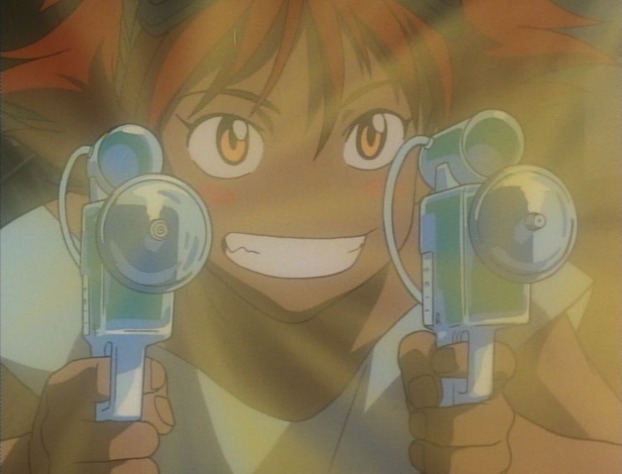
Contrast this with Shaft’s motivation. Shaft’s brother died from eating a tainted mushroom that Domino sold him. Since that day, Shaft has been walking the earth dragging a coffin behind him, waiting for the day that he could track Domino down, kill him, and stuff his body in the coffin. That’s a pretty epic plan, in its grim and terrible way. But here’s the thing about those epic plans: the universe doesn’t care about your dead brother. Or your plan. Or your fancy coffin.
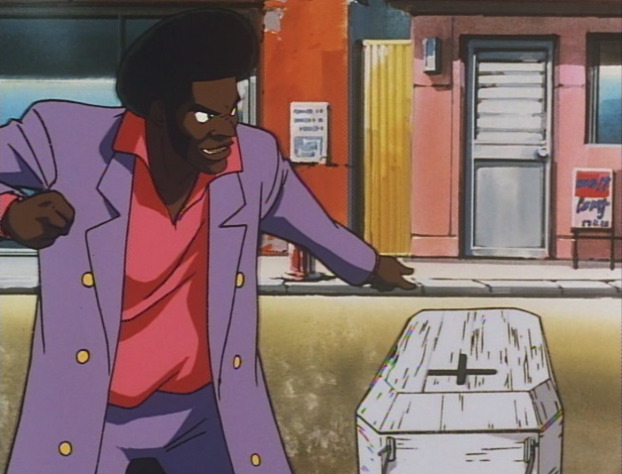
"And I'm going to put your body in -"
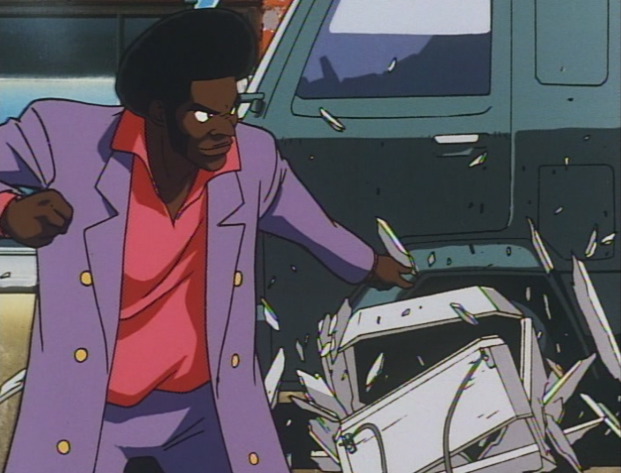
CRASH!
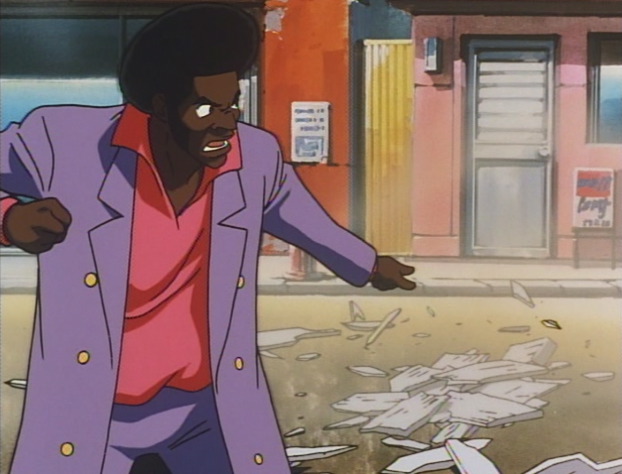
"D'oh!"
Now, the image of someone dragging a coffin around with them is pretty obviously drawn from Moby-Dick (which is also the name of the cafe where Shaft goes to drown his sorrows in ice cream after his coffin gets smashed), and this makes a lot of sense too. Because the message of Moby-Dick is basically the same as the message of Mushroom Samba: all that “giving a damn” nonsense is only going to get you killed. What, after all, is Captain Ahab, but the giver of the greatest possible damn? What is Radical Edward, but a jovial Stubb trapped in a world full of madly tilting Ahabs? And this is also the message (or one possible reading of the message) of all those earlier episodes where people have to dig up and relive the traumatic events of their pasts. There’s a line near the end of “Black Dog Serenade” where Fad complains that Jet couldn’t let go, couldn’t just leave well enough alone. Jet’s response – the whole episode’s response, really – is that of course he couldn’t, because that’s not what a Man does. He keeps digging until he finds the truth, even if it kills him. This is a very standard noir trope, maybe the noirest trope there is. But although the noir hero’s behavior is generally held up as brave, it’s actually thoroughly conventional. Mushroom Samba, on the other hand, dares to suggest that one might want to think about actually… letting… go!
(Incidentally, this is not unheard of within noir itself. The book version [spoilers ahead] of The Maltese Falcon pretty much comes to the decision that taking the noir hero route makes Sam Spade a giant asshole, and the hero of The Glass Key (also by Dashiell Hammett), gets to live happily ever after because he’s willing to walk away from a fight. But it’s not very common. When the Coen brothers remade The Glass Key as Miller’s Crossing, they decided to change the ending to a typical noirish downer.)
So, what else. That’s pretty much it as far as the main plot goes. But isn’t it interesting that this episode, where there is literally nothing at stake at all, is so much richer for analysis than the “weighty” Black Dog Serenade?
We should also take a minute to analyze the three main characters’ acid freakouts.
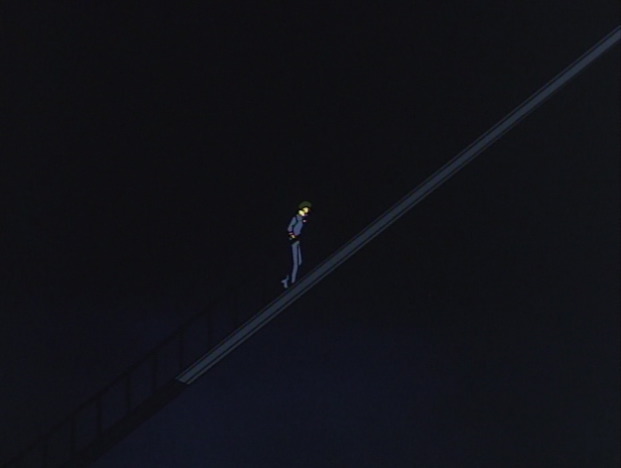
Spike finds himself climbing an infinite staircase, which we’re told is “The Staircase to Heaven.” I take this to mean that he has a death wish. Pretty obvious, really. Although it is funny that he wakes up in the morning on top of the BeBop, looking around like “How did I get up here?!”
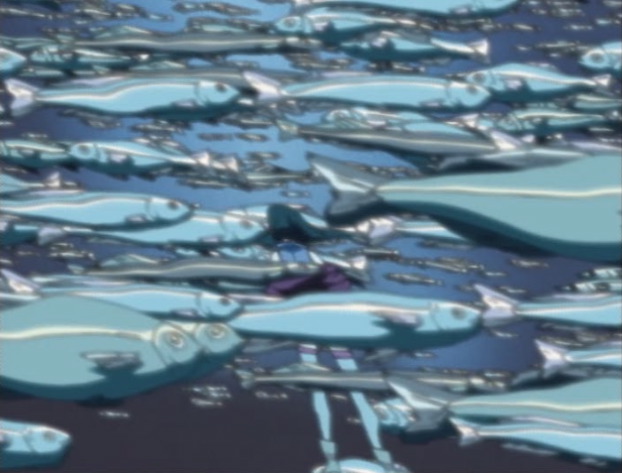
Faye goes into the bathroom and imagines herself in the kingdom of the fishes. This isn’t meaningful as such — but there’s a pattern of images at work here, where Faye and things from Faye’s life are shown to travel into and out of some kind of watery abyss. In “My Funny Valentine” we had an editing juxtaposition of Faye being pulled from cryo storage and Jet pulling a package of frozen fish out of the BeBop’s freezer. The insurance company that froze her in the first place is called “Tortus,” i.e. turtle. We’ll get into this more in the discussion of the next episode, which is all about Faye. Her morning after shot is also kind of funny, although for some people the idea of putting toilet paper in your mouth is too gross to even laugh at.
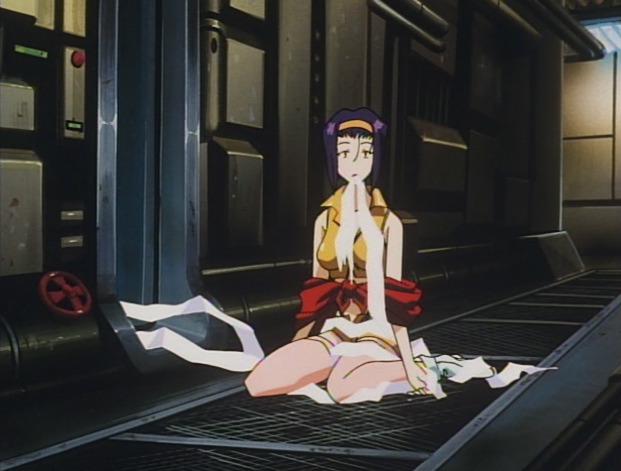
As for Jet… Jet is an interesting case, because we never get to see what he sees. He seems to have a really good time, yukking it up with his pet bonsai trees, but we only see his delusion from the outside. I think this might mean that the writers are pretty much done giving him any character development. He’s made his peace with the woman what done him wrong, he’s gotten revenge for his busted arm, he’s beginning to establish emotional ties with the people around him… maybe there’s nowhere else to take him. But as for his morning after shot…
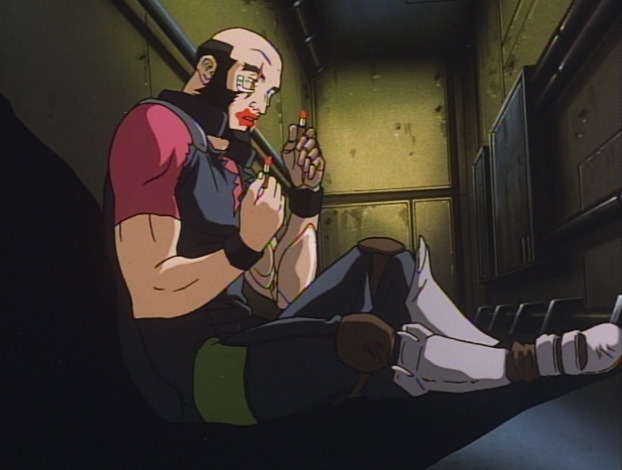
Okay, yikes.
While it’s probably a given that any “crazy blaxploitation” episode is going to have its share of uncomfortable racial moments, this one stapled my eyebrows to my hairline, as did all the business with the watermelons. Granted, Jet wasn’t actually putting on blackface. Granted, the only character who really shows any interest in the watermelons is Edward. Still, it’s VERY uncomfortable, and needs a little explanation.
Cowboy Bebop tends to rework earlier pop culture in a way that is, for want of a better word, cubist. You see lots of individual facets — symbols, images, themes — of Kung Fu movies (in “Stray Dog Strut”), or the Alien franchise (in “Toys in the Attic”), or Film Noir (passim) or whatever it might be, but the individual facets aren’t connected to eachother in the way that you would normally expect. The other thing to note is that these exploded pop culture artifacts are never really the main point of the episode: they’re just a backdrop for some completely unrelated story. “Mushroom Samba” is no exception. The backdrop is a cubist reworking of “Hollywood’s depiction of African Americans, from the 1920s to the present.” The main point of the story, which I covered at length above, has nothing to do with this. And to an American audience, this is really hard to take, because to an American audience a lot of these individual symbols are straight-up Unclean Things that can only be handled while wearing the narrative equivalent of a hazmat suit. An episode of Cowboy Bebop that was about race relations would be one thing. An episode where Shaft, and watermelons, and giant painted-on lipstick grins are just sort of casually floating around the background for no good reason? Is quite another. Before we get too offended, we should remember that Cowboy Bebop was produced by and for Japanese culture. The racial traumas that shaped our society did not shape theirs, and this means that the standards for what constitutes “racism” in art have to be a little different. But if it’s a Japanese show, I’m still an American audience, and I don’t think it’s responsible (or really even possible) for me to slip on some special Japan-o-Specs and try to watch this episode from a place where these symbols are not disturbing. Like the gender/sexuality stuff in “Jupiter Jazz,” or the disability stuff in “Waltz for Venus,” or the little whiffs of misogyny that keep on popping up all over the place, it’s something that you have to confront and deal with if you’re planning to really enjoy the show.
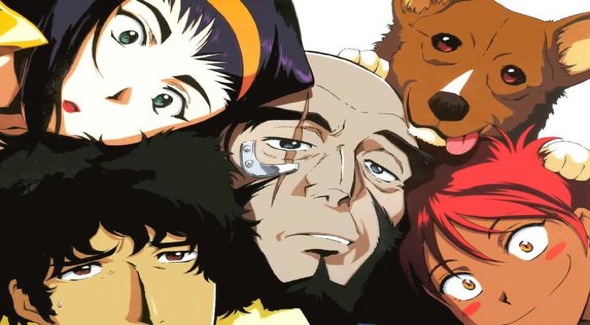
Great post, as usual, Stokes. Two completely unrelated things:
1. What did you think of the cow in the mushroom episode? :)
2. I absolutely love your reading of Speak Like a Child. It just goes to show how right you are when you say that our 14-year-old selves are dead, because when I was 14 and watching Bebop for the first time, that episode made me say WTF? And I just moved on. I only figured out the second time I watched the show a couple of years ago that it’s clearly one of the best and–ahem–deepest episodes.
Several more unrelated things:
3. I find it funny that you characterize Jet as the “dad” character, because I’ve always thought of Jet as the ship’s “mom.” He’s always cooking, wearing an apron, pruning plants, having emotional outbursts — not that dads can’t do this, of course, but Jet’s outbursts to me see coded as “feminine.” The fact that he sometimes dissolves into sexism strikes me, then, as ironic.
4. If you like your Bebop meta-literary, just wait for “Brain Scratch.” It may blow (or scratch) your brain.
5. Oh, man! Next time, you’re going to see “Cowboy Funk” AND the crazy Batman-inspired episode (well, I think it’s Batman-inspired, anyway)? I cannot wait. (/ Underthinking It)
6. Ever give any thought to overthinking another anime series? Because Neon Genesis Evangelion is just sitting there, waiting around with its insane Judeo-Christian/Freudian imagery with no one to talk to. Unfortunately the music in that show isn’t nearly as good, and the tone is more serious by a factor of, like, a million… But it’s surely worth a watch.
I’ll give my full commentary on this and part 1 of Stokes’ OTI of Cowboy Bebop when I get home from work but I’d like to recommend that you ignore that request from mlawski to shy away from Neon Evagelion Genesis for two reasons: 1, it’s Judeo-Christian imagery literally makes no sense and is fully admitted by the director Anno was picked because it was foreign to its intended Japanese audience (as opposed to being fitting symbolism). And 2, NGE is a full blown deconstruction of the Super Robot Genre of anime. It’s much more poignant to have seen a handful of Super Robot series so you can compare/contrast the characters and their mecha.
I must say there something amusing, Ed was original meant to be a little black boy, but the director decided to balance male and female on the bebop and to base the character on the composer in term of persona (though I can’t say if the previous concept was similiar)
So its strange that the ed-centric episode as a lot of element blackpoitation
Another brilliant analysis! My favorite was your take on “Black Dog Serenade.” I had come up with a similar conclusion about Spike and Jet. (quote)What’s interesting is that when he’s part of the Jet+Fad team, he plays the same role that Spike plays in the Jet+Spike+Faye team: running off half-cocked, pointlessly risking his life, taking on an unspeakable badass in a close-quarters knife fight more or less just for the hell of it. The way that Fad dies in his arms at the end of the episode even has some resonance with the way that Rocco and Gren each died in Spike’s arms in their respective episodes. So if “Black Dog Serenade” explains anything about Jet’s character, it’s his weird co-dependent relationship with Spike. He never actually comes out and says “You remind me of myself, when I was your age,” but after watching this I’m not sure he even needs to.(quote)
Yeah, totally!
@mlawski, Stokes will find out on the next DVD that Jet IS the mom. :D
My Funny Valentine and Speak Like A Child also give us a viewpoint of what the future is. Faye at the beginning of My Funny Valentine is a blank slate but she has idealism for the future once she gets past freaking out and groping holograms. Things look like they might just work out: she’s going to work off the debt, she’s got a love interest and she’s adapted to the future only for Life to suckerpunch her. Her cynism begins at that moment when her George Clooney saddles her with more debt and leaves her to fend for herself. Then the video of teenage Faye wishing her future self all the best with a cheer of encouragement also showcases the idealism that Faye lost.
Jet’s misogyny ties into his whole persona as ex-cop and as the Black Dog. Men aren’t raised and don’t act like Jet. He’s the last of the Old Guard and his age as well as older world view dictate that to the viewer. This hits a bigger note in Japan as well. Women, despite having much more modern standing in society and the workplace, still face discrimination (with the whole Christmas Cake analogy that pops up in Japanese media jumping to mind).
Ed was picked to go gather food because of who she is: a kid. Someone on the planet would feel the need to help a child out. Sending Jet, Spike or Faye out to beg for food (as we all know from previous experience, they are broke) is a gamble. It also keeps Ed from repairing the ship with whomever stays behind. Seriously, would you trust Ed with a blowtorch? I’d also argue that Ed’s haul of shittake mushrooms is a pyrhic victory at best. Ed got them a lot of mushrooms but the lack of variety (especially with no guuarantee of income), you can argue that they’re merely surviving as opposed to living.
The nerdy guy who owns all the vintage electronics is more parody of the geek (otaku) who populate the shops in the Akihabara district than a writer insert (although the two aren’t mutually exclusive). Which makes it much more amusing that Spike and Jet have to go into the den of geeks to get the betamax player.
An aside, “My _____ works when I kick it” has entered my vanacular after I saw Speak Like a Child.
Another great analysis. I love reading them and look forward to the next one. FYI the Pam Grier character in Mushroom Samba is actually called “Coffee” in the closing credits. So… yeah.
I have to agree with RiderIon about Evangelion. I do like the series, and it stands on its own without having seen any other mecha series, but it’s better to watch with at least one or two of the more standard mecha series it’s deconstructing under your belt.
On a similar note, I’d love to recommend Revolutionary Girl Utena, a series that is pretty much tailor-made for a site like this. But it takes a deconstructor fleet to shoujo tropes. Another one that works on its own, but is better judged with a knowledge of where it came from.
So I’ll offer up a compromise. FLCL. It’s short, only six episodes. It’s quickly paced. And despite the surface wackiness, there’s enough meat there to dig in to. It’s also by the same studio that did Evanglion.
Of course, I want to see the rest of what you have to say about Cowboy Bebop first. I haven’t watched this series in a long time, and you’re making me think I need to watch again and pay attention.
@Wraith, you really should watch it again. :)
I’ve watched Cowboy Bebop from beginning to end at LEAST a dozen times since last June, and every time I watch it, I find something new that I missed in all the previous viewings. Either I’m not that observant or there is just so much there that it’s hard to get it all in one viewing.
I have my own opinions on Bebop, and I’m really enjoying stokes’ persepective. We don’t differ that much on a lot of things Bebop.
SLIGHTLY OFF-TOPIC, SORRY!
@Wraith: Okay, your argument about watching Revolutionary Girl Utena was so strong that I couldn’t allow myself to pass it up. That’s right: I actually watched three episodes of it last night when I couldn’t sleep. And HOLY CRAP is that show weird. Epically, epically weird. I think I may be in love. (And, yes, I have far too much experience with shoujo anime/manga, so it’s completely rocking my world. Inverted gender roles ho!)
Speaking of weird: I dunno, Stokes, FLCL may be the weirdest anime I’ve ever seen (and that’s including Evangelion, Serial Experiments Lain, Paranoia Agent, and the three episodes of Utena I watched last night). I might need to watch it again, but I definitely got the impression that it was mostly weird for weirdness’ sake, not for Overthinkers’ sakes.
You know what, Stokes? Forget what I said about Evangelion. Neither of us should watch any anime again ever. The bad stuff is AWFUL, and the most of the good stuff is 2001: A Space Odyssey-levels of bizarre. Neither really makes for good overthinking, in my view.
Although one of these days I’m going to write my post about how Miyazaki’s Spirited Away is a Marxist allegory…
@MrsSpooky: My tastes have definitely… matured, I guess you’d say, since the last time. I’m currently in the middle of a Crest/Banner of the Stars rewatch, but I think I’ll move Cowboy Bebop into the queue after it.
@mlawski: Utena is pretty high on my top-ten list, so I’m always happy to get others hooked on it. It’s harder to find in the US than I’d like it to be, though.
Paranoia Agent, yeah, that’d be another interesting selection.
As for FLCL, it’s best summed up as animated male adolescence, which gives it an interesting quality and more than one layer. Plus plenty of weirdness for weirdness sake, yes.
My all-time favorite anime is Haibane Renmei, which would be another good one for this series. I’m just more than a little obsessed with it, so I try not to go overboard with talking about it (any more than I already have). The pacing might throw off people who aren’t used to Asian cinema, but the series itself is simply wonderful. Not even far out there on the bizarre scale.
@Wraith: Actually, I already wrote about Paranoia Agent here, if you haven’t checked it out already:
http://www.overthinkingit.com/2009/03/24/overthinking-anime-kawaii-culture-superflat-and-the-bomb-in-paranoia-agent/
@mlawski The movie for Utena is completely off the deep end. It condenses the series down to about an hour and then…it gets really weird. I’d say more but…it’d ruin the surprise.
I watched an episode or two of Utena – which, due to the opening credits, I like to refer to as “Revolving Girls Utena” – a few months back, based on a description of the music as “the Vienna Boys Choir singing Megadeth in Japanese.” I’m a big fan of cinematic excess, so as you can imagine I pretty much loved it. But it would be hard for me to overthink. It seems to be one of those shows that’s always playing the signification game; where “What does THAT mean… maybe it’s about sex?” is pretty much the intended audience response. This is fine – great, even – but it means that trying to decode the symbolism is only “thinking it,” but refusing to decode the symbolism is like refusing to laugh at a comedy. Also, the like, ten minute segment of recycled footage at the climax of each episode gets pretty brutal when you’re watching episodes back to back.
I would like to see FLCL, although it is almost too odd for words.
How about some Fullmetal Alchemist? Some of the metaphors are blatant, but have great depth and since there are two different anime series the differences between them could provide much Overthinking fodder.
And why must we stay with series? Could we not also include full length movies? Specifically Akira. Unless there is an article on this already, in which case I would like a link.
I’d very much like to see this followed by Samurai Champloo actually, since the two series are very similar but extremely different. (Not to mention the obvious Watanabe link)
I met a girl at a party once who’d written more than one graduate paper on FLCL. I think that in spite (or more likely because) of its strangeness it stands as one of the better bildungsromans out there.
I wish i had discovered your breakdowns earlier! Gj! Interesting thought, i actually think the coffin was inspired by Django [1966] as well as Moby Dick.
The tape followed Faye’s cryotomb while she was frozen in it, until it finally reached her three years later when she was rewoken.